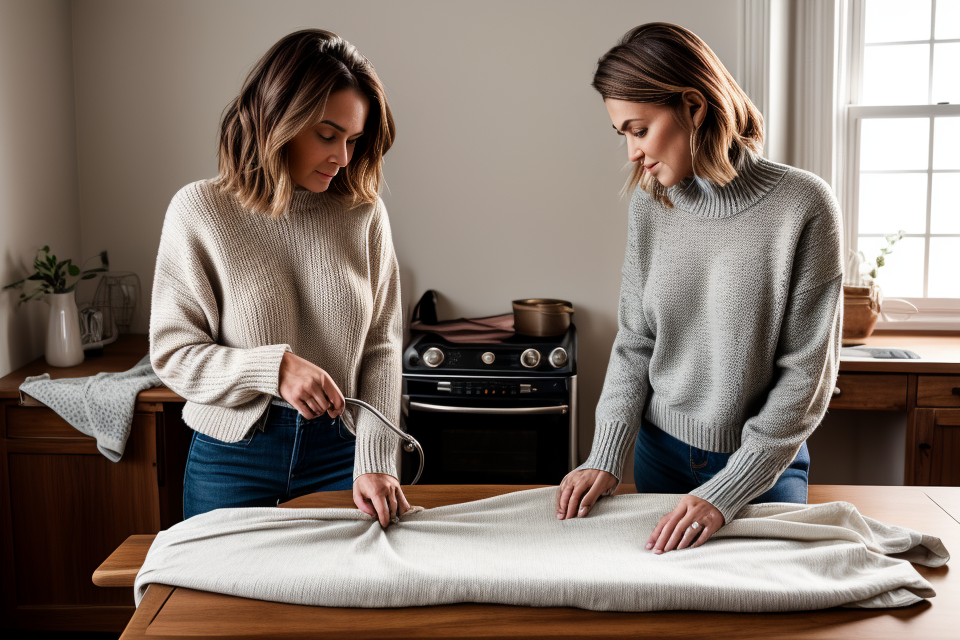Sweaters are a wardrobe staple for many, providing warmth and comfort during the colder months. But what happens when you need to iron your sweaters? Can ironing ruin your sweaters? This topic has been a subject of debate among fashion enthusiasts for quite some time. While some argue that ironing can help keep sweaters looking neat and tidy, others warn that it can cause permanent damage to the fabric. In this article, we will explore both sides of the argument and provide tips on how to care for your sweaters. So, whether you’re a fan of ironing your sweaters or not, read on to find out more.
Ironing can potentially ruin your sweaters if done improperly. High heat and direct contact with the iron can cause damage to the fibers and lead to shrinkage, deformation, and even holes in the fabric. However, if done correctly, ironing can help to remove wrinkles and creases and restore the original shape of the sweater. It is important to use the correct iron setting and to test a small, inconspicuous area first before ironing the entire sweater. Additionally, sweaters made of delicate materials such as cashmere or silk should be ironed with caution or avoided altogether.
Is It Safe to Iron Sweaters?
Types of Sweaters That Can Withstand Ironing
While ironing is generally not recommended for sweaters, there are certain types of sweaters that can withstand the process without any damage. Here are some examples:
- Sweaters Made of Natural Fibers
Sweaters made of natural fibers such as wool, cotton, and linen can tolerate ironing better than those made of synthetic materials. This is because natural fibers have a lower melting point and are less prone to melting or burning when exposed to heat. - Sweaters with a Polyester or Cotton Blend
Sweaters that are made of a blend of polyester and cotton can also withstand ironing. Polyester is a synthetic fiber that has a high melting point, making it less susceptible to damage from heat. Cotton, on the other hand, is a natural fiber that can tolerate heat without suffering any significant damage. - Sweaters with a Thick or Sturdy Weave
Sweaters with a thick or sturdy weave, such as those made of chunky yarn or knit with a dense stitch pattern, can also withstand ironing. This is because the thicker weave provides more stability and support for the fabric, making it less prone to wrinkles and damage from heat.
It’s important to note that even if a sweater falls into one of these categories, it’s still important to exercise caution when ironing it. Use a low heat setting and test a small, inconspicuous area first to ensure that the fabric can withstand the heat without sustaining any damage.
Types of Sweaters That Can’t Withstand Ironing
Certain types of sweaters are not suitable for ironing due to their delicate materials or construction. These sweaters may become misshapen, lose their texture, or even shrink if subjected to heat from an iron. It is important to be aware of which types of sweaters cannot withstand ironing to avoid damaging them.
Some of the most common types of sweaters that can‘t withstand ironing include:
- Acrylic sweaters: Acrylic is a synthetic fiber that is prone to melting when exposed to heat. Ironing an acrylic sweater can cause it to lose its shape and become misshapen.
- Cashmere sweaters: Cashmere is a soft and delicate fiber that can easily shrink or lose its texture when exposed to heat. Ironing a cashmere sweater can cause it to become thin and lose its softness.
- Cotton-blend sweaters: Sweaters made from a blend of cotton and other fibers may not be suitable for ironing. Cotton is a natural fiber that can shrink when exposed to heat, and the other fibers in the blend may also be sensitive to heat.
- Sweaters with intricate designs or patterns: Sweaters with delicate embroidery, beading, or other intricate designs may not be suitable for ironing. The heat from an iron can cause these details to shrink, fade, or even burn the fabric.
It is important to note that not all sweaters are created equal, and some may be more heat-resistant than others. However, it is always best to err on the side of caution and avoid ironing sweaters that are not specifically designed for it.
How to Iron a Sweater
Preparing the Sweater for Ironing
Before ironing a sweater, it is important to prepare it properly to avoid any damage. Here are some steps to follow:
- Check the care label: The first step is to check the care label on the sweater to see if it is safe to iron it. Some sweaters may be labeled as dry clean only, which means that ironing is not recommended.
- Inspect the sweater: Look for any loose threads, stains, or tears that may affect the ironing process. If there are any issues, it may be best to have the sweater professionally cleaned before ironing.
- Turn the sweater inside out: Ironing a sweater inside out can help protect the outside fabric from any burns or marks. Turn the sweater inside out and check the care label to make sure it is safe to iron inside out.
- Use a low heat setting: When ironing a sweater, it is important to use a low heat setting to avoid burning the fabric. A setting of around 250-300 degrees Fahrenheit is usually sufficient.
- Use a silicone-based fabric protector: Using a silicone-based fabric protector can help prevent any damage to the sweater during ironing. Apply a small amount to the fabric and spread it evenly using a cloth.
- Iron in small sections: To avoid any creases or wrinkles, iron the sweater in small sections. Start at the top and work your way down, using a circular motion to smooth out any wrinkles.
By following these steps, you can help ensure that your sweater is properly prepared for ironing and reduce the risk of any damage.
Ironing the Sweater
Ironing a sweater can be a daunting task, especially if you are unsure of the correct method. The wrong technique can cause permanent damage to your sweater, resulting in a loss of its shape, color, and texture. Here are some tips on how to iron a sweater safely and effectively:
1. Start with the right equipment
Before you begin ironing your sweater, make sure you have the right equipment. You will need an iron with a ceramic or stainless steel soleplate, as these materials are less likely to damage the fabric. Additionally, use a steam iron, as it will help to loosen any wrinkles and creases in the fabric.
2. Choose the right setting
Select the appropriate ironing setting on your iron. For sweaters, it is recommended to use a low to medium heat setting, as high heat settings can cause the fabric to shrink or burn. Additionally, make sure to set the iron to the steam setting, as this will help to loosen any wrinkles and creases in the fabric.
3. Iron in sections
Ironing a sweater in one go can be difficult and time-consuming. Instead, it is recommended to iron the sweater in sections. Start by ironing the collar and cuffs, then move on to the body of the sweater. This will help to prevent the fabric from becoming too hot and damaged.
4. Use a pressing cloth
Using a pressing cloth is a great way to protect the fabric of your sweater from damage. A pressing cloth is a piece of cloth, such as a cotton tee-shirt, that is placed between the iron and the sweater. This will help to prevent the iron from damaging the fabric and will also help to distribute the heat evenly.
5. Iron in one direction
When ironing a sweater, it is important to iron in one direction. This will help to prevent the fabric from becoming stretched or distorted. Start at the collar or cuffs and work your way down to the hemline, ironing in a straight line.
6. Use steam spray
Steam spray is a great way to add extra moisture to the fabric, which can help to loosen any wrinkles and creases. However, it is important to use steam spray sparingly, as too much moisture can cause the fabric to become too wet and potentially damage the sweater.
By following these tips, you can iron your sweater safely and effectively, ensuring that it looks great and lasts for years to come.
Finishing the Ironing Process
When you’ve finished ironing your sweater, it’s important to take a few extra steps to ensure that it looks its best and lasts longer. Here are some tips for finishing the ironing process:
- Allow the sweater to cool completely before putting it on. This will help prevent any discoloration or damage from body heat.
- Fold the sweater carefully and store it in a cool, dry place. Avoid hanging sweaters by the sleeves, as this can stretch them out of shape.
- If you’re not going to wear the sweater for a while, consider putting it in a garment bag or storing it in a box. This will help protect it from dust, moths, and other elements that can damage clothing.
- Consider using a sweater stone or other specialized tool to remove any remaining wrinkles or creases. These tools can help you achieve a professional-looking finish without damaging the fabric.
By following these tips, you can help ensure that your sweaters stay looking their best for years to come. Whether you’re a beginner or an experienced ironer, taking the time to finish the ironing process properly can make a big difference in the long run.
Tips for Ironing Sweaters
How to Avoid Damaging Your Sweaters
Ironing can be a useful way to remove wrinkles and creases from your sweaters, but it can also damage them if not done properly. Here are some tips to help you avoid damaging your sweaters when ironing:
- Use the right type of iron: A sweater iron is best for ironing sweaters because it has a wider sole plate and more pressure, which helps to distribute the heat evenly and prevent wrinkles. If you don’t have a sweater iron, you can use a regular iron, but be sure to set it to the lowest setting and use a pressing cloth or cotton tee-shirt to protect the fabric.
- Check the care label: Before ironing your sweater, check the care label to see if it’s safe to iron and if there are any specific instructions. Some materials, such as cashmere and angora, are sensitive to heat and should be dry cleaned only.
- Use a pressing cloth: A pressing cloth is a piece of cotton or linen that you place between the iron and the sweater to protect the fabric from the heat. It also helps to absorb any excess moisture, which can prevent streaks and marks.
- Don’t iron over embellishments: Embroidery, beading, and other embellishments can be damaged by heat. Avoid ironing over these areas or use a lower setting and a pressing cloth to protect them.
- Steam your sweater: Steaming your sweater can help to remove wrinkles and creases without using heat. You can use a steamer or a water spray bottle to add moisture to the fabric and help it to stretch and conform to your body shape.
- Avoid using water: Using water to iron your sweater can cause it to shrink or become stretched out of shape. If you need to remove wrinkles from a wet sweater, lay it flat to dry before ironing.
By following these tips, you can help to ensure that your sweaters stay in good condition and look their best for years to come.
How to Get the Best Results When Ironing Sweaters
Ironing sweaters can be a daunting task, especially if you don’t want to ruin them. To get the best results when ironing sweaters, here are some tips to keep in mind:
- Always pre-wash your sweaters before ironing them. This will remove any excess dye, sizing, or finishes that could interfere with the ironing process.
- Use a low setting on your iron when ironing sweaters. The lower the setting, the less heat is applied to the fabric, which can help prevent shrinkage and damage.
- Iron in small sections, starting at the underarm and working your way down to the hem. This will help you control the iron more effectively and prevent the fabric from buckling or wrinkling.
- Use a steam iron if possible, as it can help add moisture to the fabric and make it easier to smooth out wrinkles.
- Always place a towel or piece of cloth over the area you’re ironing to protect the fabric from the heat of the iron. This can also help prevent the iron from slipping and moving around while you’re ironing.
- If you’re unsure about how to iron a particular area of the sweater, such as a zipper or button, start by ironing around it and then gradually work your way towards it. This can help prevent damage to the fabric and allow you to control the iron more effectively.
By following these tips, you can help ensure that your sweaters come out looking their best after ironing.
Common Mistakes to Avoid When Ironing Sweaters
Ironing Sweaters at the Wrong Temperature
When it comes to ironing sweaters, using the wrong temperature can cause irreversible damage. The wrong temperature can ruin the texture, color, and overall appearance of your sweater.
- Using a temperature that is too high can melt the fibers and cause the sweater to lose its shape and appearance. This can result in the sweater becoming misshapen, with uneven texture and discoloration.
- On the other hand, using a temperature that is too low can cause the sweater to wrinkle and not get smoothed out properly. This can leave your sweater looking dull and lackluster.
It is important to choose the right temperature based on the type of fabric your sweater is made of. Different types of fabric require different temperature settings when ironing. For example, wool sweaters should be ironed at a lower temperature than cotton sweaters.
To avoid ruining your sweater, it is important to read the care label on your sweater and follow the recommended temperature setting. If your sweater does not have a care label, you can check the internet for recommendations based on the type of fabric your sweater is made of.
Additionally, it is important to use a pressing cloth or fabric when ironing your sweater to protect the fibers and prevent damage. A pressing cloth is a piece of cotton or linen fabric that is used to absorb the heat from the iron and protect the sweater from the direct heat of the iron.
In summary, ironing sweaters at the wrong temperature can cause irreversible damage to your sweater. It is important to choose the right temperature based on the type of fabric your sweater is made of and to use a pressing cloth to protect the fibers and prevent damage.
Ironing Sweaters for Too Long
Ironing sweaters for too long can be detrimental to their overall quality and appearance. Over-ironing can cause several issues, such as:
- Loss of texture: When sweaters are ironed for too long, the fibers may become flat and lose their natural texture, leading to a less-than-desirable appearance.
- Burn holes: Ironing for extended periods can cause the sweater to overheat, which may result in burn holes that can’t be repaired.
- Shorter lifespan: Excessive ironing can weaken the fibers and reduce the sweater’s overall lifespan, meaning it may wear out faster than it should.
To avoid these issues, it’s crucial to monitor the ironing process closely and remove the sweater from the iron when the desired level of smoothness is achieved. Regularly checking the iron’s temperature and ensuring it is appropriate for the sweater’s fabric type is also essential.
By being mindful of the time spent ironing and paying attention to the sweater’s condition, you can help preserve its quality and ensure it remains a cherished wardrobe staple for years to come.
Using the Wrong Type of Iron for Sweaters
Ironing sweaters is a delicate task that requires the right tools and techniques to avoid ruining them. One of the most common mistakes people make when ironing sweaters is using the wrong type of iron. Here are some details to consider when choosing the right iron for your sweaters:
- Types of Irons: There are two main types of irons: traditional irons and steam irons. Traditional irons are better for ironing sweaters because they only use heat, whereas steam irons can damage the fibers of the sweater by adding extra moisture.
- Ceramic or Stainless Steel: Both ceramic and stainless steel irons can be used for ironing sweaters, but ceramic irons are better because they heat up faster and reach higher temperatures. This ensures that the sweater is ironed evenly and quickly.
- Adjustable Temperature: It’s important to choose an iron with adjustable temperature settings, as different types of sweaters require different heat settings. Wool sweaters, for example, require a lower heat setting than synthetic sweaters.
- Anti-Drip Feature: Look for an iron with an anti-drip feature to prevent water droplets from falling onto the sweater and causing damage.
- Soleplate: The soleplate of the iron should be flat and smooth to ensure even pressure when ironing the sweater. A soleplate with a special coating, such as a ceramic coating, can provide better results.
In summary, using the wrong type of iron for sweaters can lead to ruining them. Choose an iron with the right features and make sure to use the appropriate heat setting for the type of sweater you’re ironing.
The Verdict: Is It OK to Iron Sweaters?
Final Thoughts on Ironing Sweaters
In conclusion, whether or not ironing sweaters is a good idea depends on several factors. Here are some final thoughts on the matter:
- Type of Sweater: Different types of sweaters require different care methods. For example, cashmere sweaters are delicate and should be handled with care, while acrylic sweaters can withstand more heat. It’s important to consider the type of sweater you have before deciding to iron it.
- Iron Type and Settings: Using the right type of iron and setting the correct temperature can make a big difference in the outcome of ironing your sweater. A dry iron with a low setting is recommended for most sweaters, while steam irons can be used for delicate fabrics. Be sure to test the iron on a small, inconspicuous area of the sweater before ironing the entire garment.
- Ironing Technique: Proper ironing technique is crucial to avoid damaging your sweater. Always place the iron on a flat, stable surface and never apply too much pressure or move the iron too quickly. Be sure to iron in the direction of the fabric grain, and use a press cloth or thin towel between the iron and the sweater to prevent the fabric from buckling.
- Alternatives to Ironing: If you’re unsure about ironing your sweater, there are alternative methods of getting wrinkles out. Hanging the sweater up in a well-ventilated area can help it air dry and reduce wrinkles. You can also try using a steamer or a damp cloth to gently smooth out wrinkles.
In summary, while ironing sweaters can be a helpful way to remove wrinkles and creases, it’s important to consider the type of sweater, iron type and settings, ironing technique, and alternatives to ironing before making a decision. Taking these factors into account can help ensure that your sweaters stay in good condition and look their best.
FAQs
1. Is it safe to iron a sweater?
Answer:
It is generally safe to iron a sweater, but it depends on the type of fabric the sweater is made of. Some sweaters are made of delicate fabrics that can easily be damaged by ironing, while others are made of more durable materials that can withstand the heat. Before ironing a sweater, it’s important to check the care label to see if ironing is recommended and to follow any specific instructions provided.
2. Can ironing ruin my sweater?
Yes, ironing can ruin a sweater if done improperly. If the iron is too hot or if the sweater is not properly prepared for ironing, it can cause damage to the fibers and lead to shrinkage, wrinkles, or even holes. Additionally, some types of sweaters, such as those made of synthetic materials, can be prone to melting or burning if the iron is too hot. It’s important to be careful when ironing a sweater and to follow proper techniques to avoid damaging it.
3. What temperature should I use when ironing a sweater?
The temperature of the iron you use to iron a sweater will depend on the type of fabric the sweater is made of. As a general rule, a medium heat setting (around 350-400 degrees Fahrenheit) is suitable for most sweaters. However, it’s important to check the care label on the sweater to see if there are any specific temperature recommendations. Additionally, it’s important to use a lower heat setting for delicate fabrics and a higher heat setting for more durable materials.
4. How should I prepare my sweater before ironing it?
Before ironing a sweater, it’s important to prepare it properly to avoid damaging it. This includes checking the care label to see if ironing is recommended and following any specific instructions provided. If the care label allows for ironing, it’s important to lay the sweater flat and smooth it out before ironing. This will help to prevent wrinkles and ensure that the iron is able to glide smoothly over the fabric. It’s also a good idea to test a small, inconspicuous area of the sweater first to make sure the iron won’t cause any damage.



